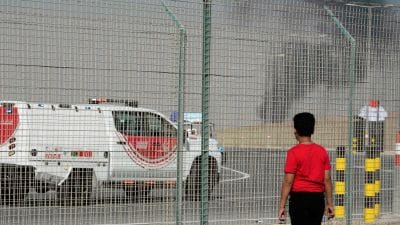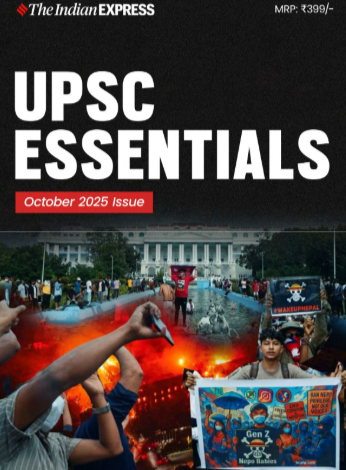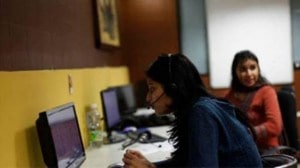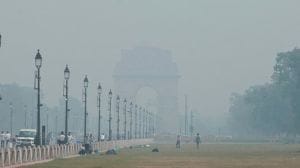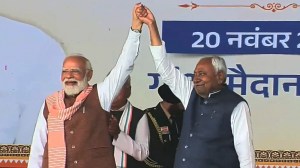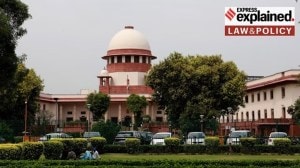
Mains Examination: General Studies-III: Indian Economy and issues relating to planning, mobilisation of resources, growth, development and employment.
What’s the ongoing story: In what appears to be a shift in strategy, the Reserve Bank of India (RBI) has seemingly relaxed its control over the rupee, allowing it to depreciate against the US dollar over the past month.
Key Points to Ponder:
• What are the different policy stances of RBI?
• What is the exchange rate?
• What determines the exchange rate?
• What factors determine the demand for rupee vis a vis dollar?
• What is the difference between rupee appreciation and rupee depreciation?
• What are the advantages and disadvantages of rupee depreciation for different sectors of the Indian economy?
Story continues below this ad
• How does the RBI’s intervention in the foreign exchange market affect liquidity in the banking system?
• Read about the Reserve Bank of India, its history and functions.
Key Takeaways:
• The apparent change in stance marks a departure from the RBI’s previous defence mechanisms, which were more rigid. In fact, it had tightly managed the rupee’s movement to prevent sharp depreciation since September 2024 till about a month ago.
• The rupee, which was moving in the range of 84-85 for quite some time, logged its steepest single-day fall in nearly two years and ended the January 13 session 66 paise down at its historic low of 86.70 against the US dollar. Since November 1, 2024, the rupee has depreciated by 2.6 per cent.
Story continues below this ad
• “The RBI’s new approach is a prudent one. If you bind the rupee to a very tight range, you also end up spending a lot of energy and resources. I think by letting the rupee go a wider range seems to be a good idea,” an analyst noted.
• The RBI sells dollars when the dollar strengthens and the rupee declines, and vice versa. It uses the foreign exchange kitty to manage the rupee movement.
• The liquidity in the system is in deficit. When the RBI intervenes in the market, it sells dollars and buys rupee. If the RBI is buying rupee, it’s taking more rupee out of the system, resulting in a liquidity deficit. The liquidity deficit is hampering money markets, which means the cost of money becomes very expensive even when interest rates are going higher. The RBI would not be desirous of that.
• The future course of the rupee depends upon whether the dollar remains here or goes higher or its scales back. The event which is going to be looked at closely is Donald Trump taking over as the US President seat on January 20, and how he delivers on the election promises he had made in terms of immigration, tax and tariffs. There’s an expectation that the currency can fall to 87 against the US dollar in March this year.
Do You Know:
Story continues below this ad
• Exchange rate: Typically, we buy goods (such as a pizza or a car) and services (such as a haircut or a hotel stay in a hill station) using our money — the Indian rupee. But there are many things where we need things from outside the country — say an American-made car or Swiss vacation or indeed, crude oil. For all such goods and services we might have to first buy the US (dollar) or Swiss currency (euro) using our domestic currency before we buy the final item. The rate at which one can swap between currencies is the exchange rate. In other words, how many rupees would buy you a dollar or a euro.
• In such a market — also referred to as the currency market — each currency is like a commodity itself. The value of each currency relative to another currency is called the exchange rate. These values can stay the same over time but more often than not they keep changing.
Other Important Articles Covering the same topic:
📍Why rupee breached 86 against US dollar: strengthening dollar, weak FII inflows
📍Why is the Indian rupee falling against the US dollar?
Previous year UPSC Prelims Question Covering similar theme:
Story continues below this ad
(1) With reference to the Indian economy, consider the following statements: (UPSC CSE 2022)
1. If the inflation is too high, Reserve Bank of India (RBI) is likely to buy government securities.
2. If the rupee is rapidly depreciating, RBI is likely to sell dollars in the market.
3. If interest rates in the USA or European Union were to fall, that is likely to induce RBI to buy dollars.
Which of the statements given above are correct?
(a) 1 and 2 only
(b) 2 and 3 only
(c) 1 and 3 only
(d) 1, 2 and 3
Story continues below this ad
GOVT & POLITICS
Syllabus:
Preliminary Examination: Current events of national and international importance
Mains Examination: General Studies II: Bilateral, regional and global groupings and agreements involving India and/or affecting India’s interests.
What’s the ongoing story: Barely days ahead of Donald Trump taking over as US President amid growing concerns over imposition of tariffs or crackdown in immigration, External Affairs Minister S Jaishankar outlined the global challenges due to “the weaponisation of market instruments and financial institutions”. At the same time, he underlined the link between economic growth and strategic “autonomy.”
Key Points to Ponder:
• What is the history of India-China relations?
• Standoff between India and China- Know about it.
• What are the internal security challenges along the LAC?
• What does the term “weaponisation of market instruments and financial institutions” mean?
• What is the status of India-US relations?
Story continues below this ad
• What are the areas of cooperation between India and the US?
• What are the potential consequences of a change in leadership in the U.S. on the India-U.S. cooperation?
• Map Work: Line of Control, Line of Actual Control, Chang Chenmo river, Gogra-Hot Springs, Kongka Pass, Galwan Valley, Depsang Plains, and Charding Nala region

Key Takeaways:
• He also framed the China challenge saying the India-China relationship is trying to disentangle itself from the complications arising from the post-2020 border situation. Even as that is being addressed, more thought needs to be given to the longer-term evolution of ties, Jaishankar said.
Story continues below this ad
• Delivering the 19th Nani A Palkhivala Memorial Lecture in Mumbai, Jaishankar said: “At a time when most of its relationships are moving forward, India confronts a particular challenge in establishing an equilibrium with China. Much of that arises from the fact that both nations are on the rise. As immediate neighbours and the only two societies with over a billion people, their dynamic could never have been easy. But it has been further sharpened by a boundary dispute, by some baggage of history and by differing socio-political systems. Mis-readings by past policy-makers, whether driven by idealism or absence of realpolitik, has actually helped neither cooperation nor competition with China. That has clearly changed in the last decade.”
• “Right now, the relationship is trying to disentangle itself from the complications arising from the post-2020 border situation. Even as that is being addressed, more thought needs to be given to the longer-term evolution of ties. Clearly, India has to prepare for expressions of China’s growing capabilities, particularly those that impinge directly on our interests. To hold up its own end, a more rapid development of India’s comprehensive national power is necessary. ” he said.
• Acknowledging that changes in US “policy and posture” will have implications for India., Jaishankar said that “because the complementarity is already strong and visible, indicators point to a robust growth in our cooperation in the days ahead.”
Do You Know:
• The Line of Actual Control (LAC) is the demarcation that separates Indian-controlled territory from Chinese-controlled territory. India considers the LAC to be 3,488 km long, while the Chinese consider it to be only around 2,000 km. It is divided into three sectors: the eastern sector which spans Arunachal Pradesh and Sikkim, the middle sector in Uttarakhand and Himachal Pradesh, and the western sector in Ladakh.
• The alignment of the LAC in the eastern sector is along the 1914 McMahon Line, and there are minor disputes about the positions on the ground as per the principle of the high Himalayan watershed. This pertains to India’s international boundary as well, but for certain areas such as Longju and Asaphila. The line in the middle sector is the least controversial but for the precise alignment to be followed in the Barahoti plains.
• According to the Maj Gen (retd) Prof G G Dwivedi, every conflict has a cycle – it begins with escalation, and is followed by contact, stalemate, de-escalation, resolution, peace-building and reconciliation. The de-escalation process entails talks at multiple levels, and ground action in various stages. For example, there have been three rounds of talks at the Corps Commander level, simultaneous talks between Joint Secretaries, and at the level of Special Representatives between India and China after Galwan clash. On the ground, the first step in the de-escalation process is of disengagement – i.e., to break the ‘eyeball-to-eyeball’ contact between the opposing troops on the forward line by pulling back to create a buffer zone. The next step is the pulling back of the troops in the immediate depth, followed by reserve formations in the rear.
• Raja Mohan writes–“Themes of concern for India stand out from Trump’s worldview.
• First is Trump’s plan to “dismantle the regulatory state,” dramatically downsize the bureaucracy, and make it easier for US capital to invest and develop new technologies.
• Second, Trump is determined to re-industrialise America. He has argued repeatedly that globalisation has played havoc with US manufacturing and the industrial working class.
• Third, immigration has been one of the issues that has propelled Trump to his historic political comeback in this election. Although his anti-immigration rhetoric has caused much concern in India, Trump has sought to differentiate between “legal” and “illegal” immigration….India will have a deep interest in contributing to the US debate on separating the “bad” immigration from the “good”.
Other Important Articles Covering the same topic:
📍Explained: China-India state of play
📍Express view on China-India thaw: Patient diplomacy is key
Previous year UPSC Prelims Question Covering similar theme:
2. “Belt and Road Initiative” is sometimes mentioned in the news in the context of the affairs of: (UPSC CSE 2016)
(a) African Union
(b) Brazil
(c) European Union
(d) China
3. Siachen Glacier is situated to the (UPSC CSE 2020)
(a) East of Aksai Chin
(b) East of Leh
(c) North of Gilgit
(d) North of Nubra Valley
Previous year UPSC Mains Question Covering similar theme:
‘China is using its economic relations and positive trade surplus as tools to develop potential military power status in Asia’, In the light of this statement, discuss its impact on India as her neighbour. (UPSC CSE 2017)
Syllabus:
Preliminary Examination: EconomicandSocial Development- Sustainable Development, Poverty, Inclusion, Demographics, Social Sector Initiatives, etc.
Mains Examination: General Studies III: Land reforms in India.
What’s the ongoing story: Terming the property cards distributed under the Centre’s SVAMITVA scheme a “guarantee of economic security”, Prime Minister Narendra Modi Saturday said these documents, once issued in all the villages of the country, will unlock economic activity worth over Rs 100 lakh crore.
Key Points to Ponder:
• What is the SVAMITVA (Survey of Villages and Mapping with Improvised Technology in Village Areas) scheme?
• How is an SVAMITVA property card generated?
• What is the benefit of issuing an SVAMITVA property card?
• What is the significance of the SVAMITVA Scheme in addressing rural land ownership issues in India?
• What is Bhu-Aadhaar?
• Evaluate the role of technology, particularly drone-based mapping, in the implementation of the SVAMITVA Scheme.
Key Takeaways:
• The Prime Minister was addressing an event to distribute over 65 lakh property cards to property owners in over 50,000 villages across 230 districts through video conferencing.
• Calling it a “historic day for the villages and the rural areas of India”, he said nearly half of the country’s more than 6 lakh villages had been surveyed by drones under the property survey programme, which was launched in 2020. He said 2.25 crore people in villages have so far received legal documents for their houses under the scheme.
• “After getting legal documents, lakhs of people have taken loans from banks on the basis of their houses and property. With this money, they have started their small business in the village. Many of these are small and medium farmer families. For them, these property cards have become a big guarantee of economic security,” the PM said.
• Calling SVAMITVA and Bhu-Aadhaar, a unique land parcel identification number (ULPIN) for each land, as foundational systems for village development, the PM said 23 crore Bhu-Aadhaar numbers have been issued so far.
Do You Know:
• The acronym SVAMITA stands for Survey of Villages and Mapping with Improvised Technology in Village Areas. It is a Central Sector Scheme aimed at “providing ‘record of rights’ to village household owners possessing houses in inhabited rural areas in villages and issuance of property cards to the property owners.” The plan is to survey all rural properties using drones and prepare GIS based maps for each village.
• The scheme was launched by the Prime Minister on National Panchayat Day i.e. 24th April 2020 and distribution of property cards began on October 11, 2020. Objectives of the scheme are:
• To bring financial stability to the citizens of rural India, enabling them to use their property as a financial asset for taking loans and other financial benefits.
• Creation of accurate land records for rural planning.
• Determination of property tax, which would accrue to the GPs directly in States where it is devolved or else, add to the State exchequer.
• Creation of survey infrastructure and GIS maps that can be leveraged by any department for their use.
• To support in preparation of a better-quality Gram Panchayat Development Plan (GPDP) by making use of GIS maps.
• To reduce property-related disputes and legal cases.
Other Important Articles Covering the same topic:
📍Explained: What is SVAMITVA, the property card for rural households?
UPSC Prelims Practice Question Covering similar theme:
4. Government of India’s ‘SVAMITVA’ scheme is related to:
(a) encouragement to employers to create new jobs
(b) property survey and mapping
(c) eradicating bonded labor in India
(d) grant for construction workers to purchase tools
Syllabus:
Preliminary Examination: Current events of national and international importance
Mains Examination: General Studies-I: Indian culture will cover the salient aspects of Art Forms, literature and Architecture from ancient to modern times.
What’s the ongoing story: Kerala’s martial art form Kalaripayattu has become a bone of contention ahead of the 38th edition of the National Games which is scheduled to commence from January 28 in Uttarakhand.
Key Points to Ponder:
• What is Kalaripayattu?
• How does Kalaripayattu present the cultural and historical heritage of India?
• Compare and contrast Kalaripayattu with other traditional Indian martial art forms.
• Read about Thang Ta, Silambam, and Gatka.
• What is the significance of Indian martial arts in promoting physical fitness and mental discipline in contemporary society?
• Read about the Indian Olympics Association.
• Know about the National Games.
• What challenges do traditional sports like Kalaripayattu face in gaining recognition as competitive sports at national and international levels?
• What measures can be taken to preserve and promote indigenous sports?
Key Takeaways:
• The Indian Kalaripayattu Federation has accused the Indian Olympics Association (IOA) of “relegating” the martial art to the demonstration section of the event. In the 37th edition of the National Games, which was held in Goa in 2023, Kalaripayattu was part of the competition section. This year, the art form has been included in the list of events for demonstration, dampening the medal hopes of around 200 Kalaripayattu athletes from 18 states who were planning to participate in the competition, the Federation said.
• IOA president P T Usha said in Kerala that the association will decide on the fate of Kalaripayattu within a week, based on the Delhi High Court order. The Delhi HC had on January 15 ordered that “a suitable decision shall be taken for reinstating Kalaripayattu as a competitive sport in the 38th National Games”.
Do You Know:
• Kalaripayattu is one of the oldest and most scientific martial art forms in the world, aimed at mind and body coordination. Talking about the same, Shinto Mathew, Gurukkal of Kalari Kendram Delhi, told indianexpress.com that in Kalari training, “the attacking and defense system of eight animals — elephant, lion, wild boar, horse, snake, fighter cock, cat, fish — is incorporated.”
• He added that there are two types of Kalaripayattu — northern and southern, which slightly differ from each other. “In north, more weapons are used as compared to south, and all movements in northern Kalari are in a straight line — forward and backward. However, down south, people can move in any direction while practicing it.”
UPSC Prelims Practice Question Covering similar theme:
5. The martial art form Kalaripayattu is related to which of the following states?
(a) Andhra Pradesh
(b) Uttar Pradesh
(c) Tripura
(d) Kerala
THE WORLD
Gaza ceasefire deal takes effect today, exchange of captives to mark first step
Syllabus:
Preliminary Examination: Current events of national and international importance
Mains Examination: General Studies II: Bilateral, regional and global groupings and agreements involving India and/or affecting India’s interests.
What’s the ongoing story: The ceasefire between Hamas and Israel will go into effect Sunday at 8:30 am local time (0630 GMT), mediator Qatar announced Saturday, as families of hostages held in Gaza braced for news of loved ones, Palestinians prepared to receive freed detainees, and humanitarian groups rushed to set up a surge of aid.
Key Points to Ponder:
• What was ‘Operation Al Aqsa Storm’?
• Know the key highlights of the ceasefire agreement between Israel and Hamas.
• What is the historical background of the Israel-Palestine conflict?
• How will the ceasefire agreement between Israel and Hamas impact regional stability in the Middle East?
• What are the socio-economic impacts of prolonged hostilities in Gaza on the civilian population?
• What is the significance of West Asia for India?
• What is the Axis of Resistance?
• Read about Hamas.
• Map work: Locations in news related to the Israel-Hamas conflict.
Key Takeaways:
• The pause in 15 months of war is a step toward ending the deadliest, most destructive fighting ever between Israel and Hamas. The first phase of the ceasefire will last 42 days, and negotiations on the far more difficult second phase are meant to begin just over two weeks in.
Do You Know:
• After 15 months of devastating war between Israel and Hamas, a ceasefire marks a critical moment in a conflict that has reshaped West Asia. The agreement, brokered through months of painstaking diplomacy by Egypt, Qatar, and the United States, aims to halt the bloodshed and initiate a release of hostages held by Hamas in exchange for Palestinian prisoners held by Israel.
• During a 42-day first phase beginning Sunday, Hamas will release 33 hostages and Israel will release between 900 and 1,650 Palestinian detainees, including all of those detained since October 7, 2023.
• The IDF will withdraw from central Gaza and the Netzarim Corridor — a 2-4-km-wide security clearing that it has created, cutting Gaza in half up to the Mediterranean — and eventually from the Philadelphi Corridor, the buffer zone along the Gaza-Egypt border.
 Netzarim and Philadelphi corridors in Gaza. (Google Maps screengrab)
Netzarim and Philadelphi corridors in Gaza. (Google Maps screengrab)
• The exchange of prisoners is a significant element of the ceasefire arrangement, with 33 of the remaining 98 hostages — primarily women, children, the elderly, and the injured — expected to be released over the next several weeks. For each group of hostages released, Israel has agreed to free nearly 2,000 Palestinian prisoners, a gesture aimed at maintaining momentum toward peace.
• Negotiations for a second phase will begin on the 16th day after the ceasefire comes into effect, and is expected to produce almost a full Israeli withdrawal from the Strip, and the release of all remaining hostages by Hamas in return for a yet-to-be-decided number of Palestinian detainees.
Other Important Articles Covering the same topic:
📍What are the key takeaways from the Israel-Hamas ceasefire agreement?
📍Israel-Hamas ceasefire kicks in, with a new hope of peace for Gaza
Previous year UPSC Prelims Question Covering similar theme:
6. The term “two-state solution” is sometimes mentioned in the news in the context of the affairs of (UPSC CSE 2018)
(a) China
(b) Israel
(c) Iraq
(d) Yemen
ECONOMY
Syllabus:
Preliminary Examination: Current events of national and international importance, Economic Development
Mains Examination: General Studies-III: Indian Economy and issues relating to planning, mobilisation of resources, growth, development and employment, Effects of liberalisation on the economy
What’s the ongoing story: In a sign that Indian companies are keen on expanding their global footprints, outward foreign direct investment (OFDI) by domestic firms has seen a jump of nearly 17 per cent to $37.68 billion in 2024.
Key Points to Ponder:
• What is outward foreign direct investment (OFDI)?
• How is OFDI different from Inward Foreign Direct Investment (FDI)?
• What are the different routes and components of FDI in India?
• What is the difference between FDI and FPI?
• Which sectors are prohibited under FDI? Where does India rank as per FDI inflows?
• What are the top 5 sectors and states receiving the highest FDI inflow? What are the top 5 countries for FDI equity inflows into India?
• What are the key factors motivating Indian companies to invest abroad through OFDI?
• What are the benefits of outward foreign direct investment?
• What role do the Reserve Bank of India (RBI) and the Government of India play in regulating and facilitating OFDI by Indian entities?
• Which sectors have experienced the highest levels of OFDI from India?
Key Takeaways:
• In 2023, total overseas direct investment stood at $32.29 billion, according to the Reserve Bank of India (RBI) data.
• Overseas direct investment means acquisition of any unlisted equity capital or subscription as a part of the memorandum of association of a foreign entity, or investment in 10 per cent or more of the paid-up equity capital of a listed foreign entity, or investment with control where investment is less than 10 per cent of the paid-up equity capital of a listed foreign entity.
• OFDI has three components — equity, loans and guarantee issued. In the last calendar year, overseas FDI by local companies in the form of equity stood at $12.69 billion, a rise of 40 per cent over the $9.08 billion invested in 2023.
• The sectors where Indian companies invest in overseas markets include hotels, construction, manufacturing, agriculture, mining and services. The countries that have seen total financial commitment by way of ODI are Singapore, US, UK, UAE, Saudi Arabia, Oman and Malaysia, among others.
• Overseas investments in joint ventures (JV) and wholly owned subsidiaries (WOS) have been recognised as important avenues for promoting global business by Indian entrepreneurs.
• Joint ventures are perceived as a medium of economic co-operation between India and other countries. Transfer of technology and skill, sharing of results of research and development (R&D), access to wider global market, promotion of brand image, generation of employment and utilisation of raw materials available in India and in the host country are other significant benefits arising out of such overseas investments.
• They are also important drivers of foreign trade through increased exports of plant and machinery and goods and services from India and also a source of foreign exchange earnings by way of dividend earnings, royalty, technical know-how fee and other entitlements on such investments.
Do You Know:
• Foreign Direct Investment (FDI) is defined as an investment in which a company takes controlling ownership of a business entity in another country. Therefore, foreign companies get directly involved with day-to-day operations in other countries.
• India gets FDI through two routes:
(a) Automatic route: Under this route, the non-resident or Indian company does not require a prior nod from the Reserve Bank of India (RBI) or the government of India for FDI.
(b) Government route: Under this route, the government’s approval is mandatory.
Other Important Articles Covering the same topic:
📍UPSC Essentials: One Word A Day- FDI
📍RBI issues new framework for reclassification of FPI to FDI
Previous year UPSC Prelims/Mains Question Covering similar theme:
7. With reference to Foreign Direct Investment in India, which one of the following is considered its major characteristic? (UPSC CSE 2020)
(a) It is the investment through capital instruments essentially in a listed company.
(b) It is a largely non-debt creating capital flow.
(c) It is the investment which involves debt-servicing.
(d) It is the investment made by foreign institutional investors in the Government securities.
Syllabus:
Preliminary Examination: Current events of national and international importance.
Mains Examination: General Studies II: Bilateral, regional and global groupings and agreements involving India and/or affecting India’s interests.
What’s the ongoing story: The US National Security Advisor Jake Sullivan may have signalled an incremental step by the outgoing Biden Administration to operationalise the Indo-US nuclear deal, including some measures to find a way around the long-standing regulations that have stymied civil nuclear cooperation between India’s nuclear entities and US companies, but the big question is this: will the incoming administration in Washington take a cue and build on this somewhat belated initiative.
Key Points to Ponder:
• Read about the Indo-US nuclear deal.
• What are the key regulatory challenges associated with operationalizing the Indo-US civil nuclear deal?
• What are Small Modular Reactors (SMRs)?
• Know about the Indian government-owned atomic bodies.
• What is the Civil Liability for Nuclear Damage Act, 2010?
• What are the challenges faced by India’s civil nuclear programme?
• What is the significance of the removal of US export controls on Indian entities like BARC in the context of the Indo-US strategic partnership?
• What steps can India take to integrate itself into the global nuclear manufacturing value chain?
• What is the role of multilateral agreements like the NPT and NSG in shaping global nuclear commerce?
Key Takeaways:
• Indications are that while the last-ditch outreach by Washington could include removing Indian government-owned atomic bodies from the US entity list, the bigger impediment holding up investments are two legal barriers on both sides.
• On the American side, it is the ‘10CFR810’ authorisation (Part 810 of Title 10, Code of Federal Regulations of the US Atomic Energy Act of 1954), which gives US nuclear vendors the ability to export equipment to countries such as India under some strict safeguards, but does not permit them to manufacture any nuclear equipment or perform any nuclear design work here. And on the Indian side, it is the Civil Liability for Nuclear Damage Act, 2010.
• The 810 authorisation is a clear impediment from New Delhi’s perspective, given that India wants to participate in the manufacturing value chain and co-produce the nuclear components for atomic power projects being jointly planned to be set up in the country, sources said.
• While there is uncertainty on how all of this will pan out post January 20, what is clear with the incoming Trump administration is that the one area of mutual interest is likely to be Small Modular Reactors (SMR). This is something that New Delhi is increasingly viewing as an area of strategic interest and Trump appears to be extremely keen to push.
• India is working to get into the manufacturing value chain of small reactors, both as a way of fulfilling its commitment to clean energy transition, and bundling SMRs as a technology-led foreign policy pitch.
• SMRs – small reactors with a capacity of 30MWe to 300 MWe per unit – are increasingly seen as important for nuclear energy to remain a commercially competitive option in the future. This is especially relevant in the wake of surging power demand from technology companies, given the massive incremental electricity requirement coming in from AI machine learning applications and data centres.
• While there are lots of different types of SMRs being developed, there are currently four main types, each using a different coolant to manage the extreme heat of a nuclear fission reaction – light water, high temperature gas, liquid metal and molten salt.
• The most common type, though, are light water reactors, which are very similar to traditional nuclear power plants being built in Russia, France and the US, which are almost all water cooled. That makes them much easier to design and get approved, as today’s nuclear regulations are mostly based on water cooled reactors.
Do You Know:
• The Civil Liability for Nuclear Damage Act, 2010, sought to create a mechanism for compensating victims for damage caused by a nuclear accident and allocating liability and specifying procedures for compensation.
• Though India’s civil nuclear programme has expertise in manufacturing smaller reactor types – 220MWe PHWRs (pressurised heavy water reactors) and above – the problem for India is its reactor technology. Based on heavy water and natural uranium, the PHWRs are increasingly out of sync with the light water reactors that are now the most dominant reactor type across the world.
Other Important Articles Covering the same topic:
📍Nuclear deal in mind, US removes curbs on BARC and two others
🚨New Year Special: Click Here to read the January 2025 issue of the UPSC Essentials monthly magazine. Share your views and suggestions in the comment box or at manas.srivastava@indianexpress.com🚨
Subscribe to our UPSC newsletter and stay updated with the news cues from the past week.
Stay updated with the latest UPSC articles by joining our Telegram channel – Indian Express UPSC Hub, and follow us on Instagram and X.

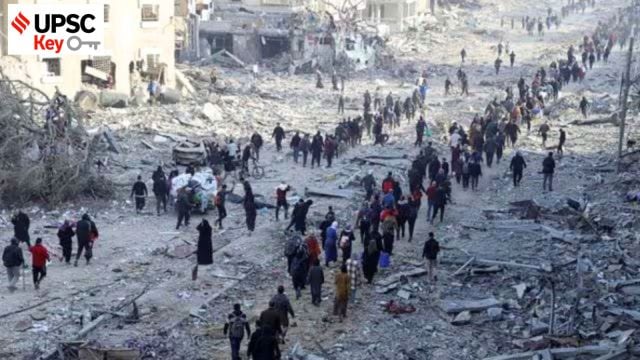


 Netzarim and Philadelphi corridors in Gaza. (Google Maps screengrab)
Netzarim and Philadelphi corridors in Gaza. (Google Maps screengrab)
